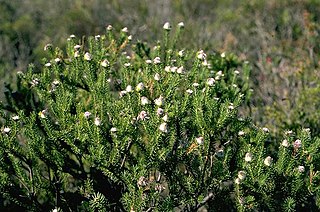
Grevillea preissii is a species of flowering plant in the family Proteaceae and is endemic to the southwest of Western Australia. It is a mounded to spreading or dense, erect shrub, the leaves divided with 5 to 7 linear to more or less cylindrical lobes, and groups of reddish flowers arranged along one side of the flowering rachis.

Grevillea endlicheriana, commonly known as spindly grevillea, is a species of flowering plant in the family Proteaceae and is endemic to the south-west of Western Australia. It is an erect shrub with linear leaves, and groups of white, pink tinged flowers.

Grevillea diversifolia, the variable-leaved grevillea, is a species of flowering plant in the family Proteaceae and is endemic to the south-west of Western Australia. It is an erect to prostrate shrub with simple or divided leaves and groups white to cream-coloured flowers with a dull red style.

Grevillea huegelii, commonly known as comb spider-flower or comb grevillea, is a species of flowering plant in the family Proteaceae and is endemic to southern continental Australia. It is an erect to low-lying shrub with divided leaves with mostly three to eleven sharply-pointed linear lobes, and clusters of red to pink flowers that are silky-hairy on the outside.

Grevillea brachystachya, commonly known as short-spiked grevillea, is a species of flowering plant in the family Proteaceae and is endemic to the south-west of Western Australia. It is a bushy shrub with linear leaves and more or less spherical clusters of cream-coloured to greenish flowers.

Grevillea cirsiifolia, commonly known as varied-leaf grevillea, is a species of flowering plant in the family Proteaceae and is endemic to the south-west of Western Australia. It is a prostrate shrub, usually with divided leaves with eight to thirty lobes, and creamy white and bright yellow flowers with a white to pale yellow style.
Grevillea pinifolia, commonly known as the pine-leaved grevillea, is a species of flowering plant in the family Proteaceae and is endemic to a restricted area in the south-west of Western Australia. It is a low, mounded shrub with linear, more or less cylindrical leaves and red to orange-red flowers.

Petrophile scabriuscula is a species of flowering plant in the family Proteaceae and is endemic to southwestern Western Australia. It is a dense, prickly shrub with sharply-pointed, needle-shaped leaves more or less pressed against the branchlets, and oval heads of hairy, yellow to creamy-yellow flowers.
Dillwynia dillwynioides is a species of flowering plant in the family Fabaceae and is endemic to the south-west of Western Australia. It is a low-lying or erect, spindly shrub with cylindrical, grooved leaves and yellow, red or orange flowers with yellow, red or orange markings.
Dillwynia stipulifera is a species of flowering plant in the family Fabaceae and is endemic to New South Wales. It is an erect to spreading shrub with hairy stems, linear leaves and yellow flowers with red markings.
Pultenaea aspalathoides is a species of flowering plant in the family Fabaceae and is endemic to the south of Western Australia. It is an erect, spindly shrub with hairy, needle-shaped leaves and yellow flowers.

Pultenaea empetrifolia is a species of flowering plant in the family Fabaceae and is endemic to the south-west of Western Australia. It is a spindly, prostrate or spreading shrub with down-curved, cylindrical, grooved leaves and yellow to orange and red flowers.

Pultenaea ochreata is a species of flowering plant in the family Fabaceae and is endemic to the south-west of Western Australia. It is an erect shrub with egg-shaped leaves with the narrower end towards the base and yellow-orange flowers with red or brown marks.

Gompholobium preissii is a species of flowering plant in the family Fabaceae and is endemic to the south-west of Western Australia. It is an erect shrub with pinnate leaves with five to fifteen leaflets, and yellow, red and orange, pea-like flowers.

Gompholobium shuttleworthii is a species of flowering plant in the pea family Fabaceae and is endemic to the south-west of Western Australia. It is an erect shrub with pinnate leaves with five to nine leaflets, and pink or purple flowers with some darker markings.

Gompholobium villosum is a species of flowering plant in the pea family Fabaceae and is endemic to the south-west of Western Australia. It is a slender, erect shrub with simple, needle-shaped leaves with one or two grooves on the lower surface, and violet, pink or purple flowers.
Pultenaea strobilifera is a species of flowering plant in the family Fabaceae and is endemic to the south-west of Western Australia. It is an open to dense, domed or spindly, erect shrub with simple leaves and yellow-orange and salmon pink to bright pink flowers.
Gompholobium viscidulum is a species of flowering plant in the pea family Fabaceae and is endemic to the south-west of Western Australia. It is an erect shrub with pinnate leaves with five to seven leaflets, and yellow flowers.

Pimelea tinctoria is a species of flowering plant in the family Thymelaeaceae and is endemic to the south-west of Western Australia. It is an erect, spindly shrub with elliptic leaves arranged in opposite pairs, and compact heads of many yellow or yellowish-green flowers usually surrounded by 4 to 7 pairs of egg-shaped to narrowly elliptic yellow and green involucral bracts.
Pimelea villifera is a species of flowering plant in the family Thymelaeaceae and is endemic to the south-west of Western Australia. It is an erect, dense shrub usually with linear to narrowly elliptic leaves arranged in opposite pairs, and compact heads of many white flowers usually surrounded by 6 to 10 pairs of green and yellowish, narrowly egg-shaped involucral bracts.













